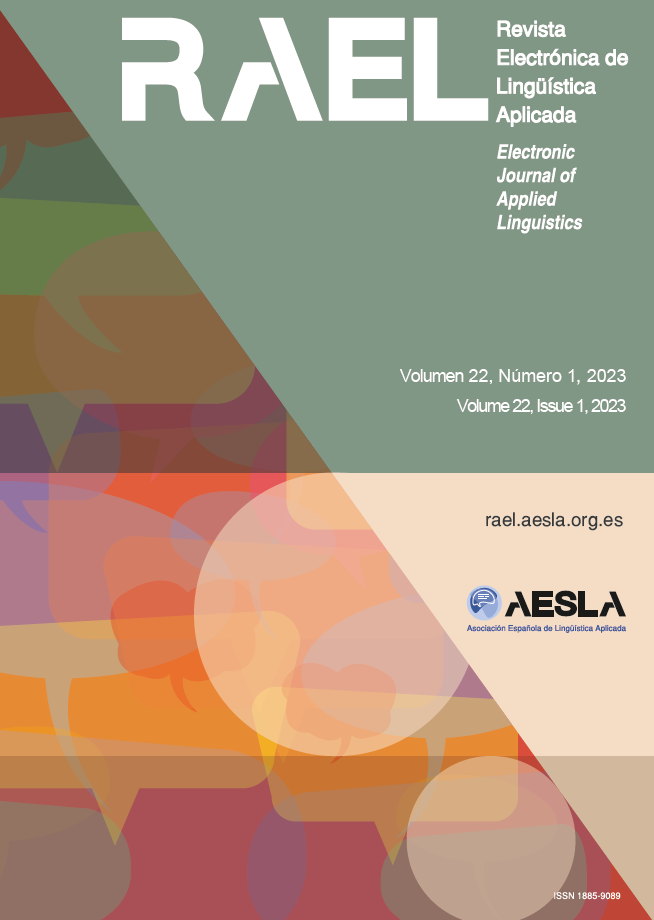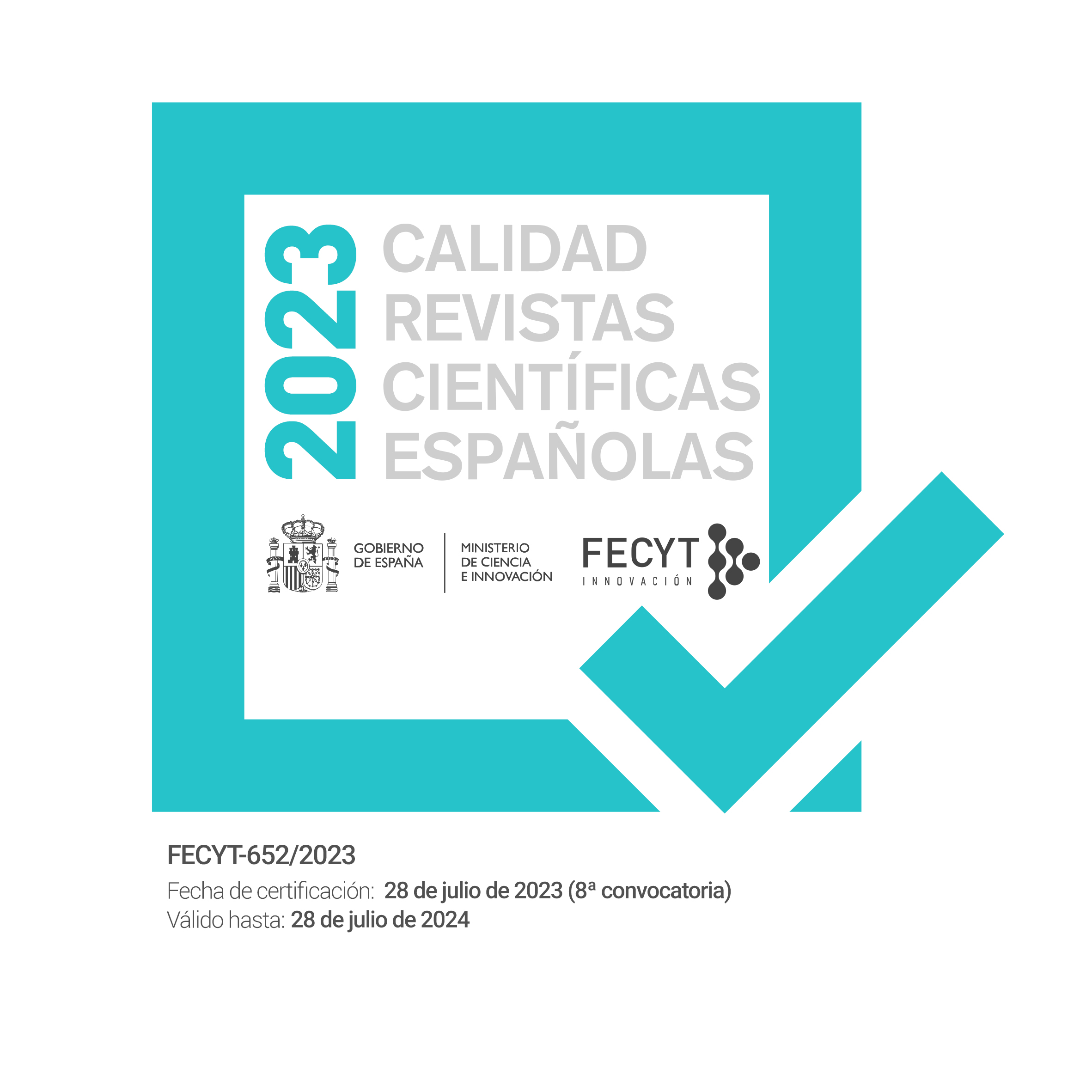The Dustman: a longitudinal case study on non-acquisition of conflated manner of motion in advanced learners of English
DOI:
https://doi.org/10.58859/rael.v23i1.512Keywords:
S-framed/V-framed languages, event conflation, non-acquisition of lexicalization patterns, overcoming the cross-boundary constraint, explicit instruction, SLA.Abstract
This case study follows seven learners of English as a Second Language for 17 years and looks into the spontaneous learnability of motion lexicalization patterns in English, specifically the path component as explained by Talmy (2000) and Slobin (1987, 2004, 2017). The results suggest that advanced Spanish learners of English who have benefited from both instructed and naturalistic acquisition show an unawareness to differences in the conceptualization of motion in the L2. As a result, learners may not develop canonical L2 lexicalization patterns, which not only lead to obvious interlanguage omissions of sanctioned forms when describing motion but can also curtail further advancement. I believe awareness of conceptual differences between languages can lead to more progress and proficiency in late advanced learners.
Downloads
Global Statistics ℹ️
|
664
Views
|
318
Downloads
|
|
982
Total
|
|
References
References
Berman, R. A., & Slobin, D. I. (1987). Five ways of learning how to talk about events: A crosslinguistic study of children's narratives. Cognitive Science Program, Institute of Cognitive Studies, University of California at Berkeley.
Berman, R. A., & Slobin, D. I. (1994-2013). Relating events in narrative: A crosslinguistics developmental study. Psychology Press. doi: 10.1080/03640210701530748 DOI: https://doi.org/10.1080/03640210701530748
Berthele, R. (2004). The typology of motion and posture verbs: A variationist account. Trends in Linguistics studies and Monographs, 153, 93-126. doi: 10.1515/9783110197327.93 DOI: https://doi.org/10.1515/9783110197327.93
- (2013). Disentangling manner and path. Variation and change in the encoding of motion events: 41, 55-75. https://doi.org/10.1075/hcp.41.03ber DOI: https://doi.org/10.1075/hcp.41.03ber
Cappelle, B. (2018). Come in/Entrez. An invitation to corpus-based research in motion typology. Manuscript, Université de Lille.
Cadierno, T. (2004). Expressing motion events in a second language: A cognitive typological perspective. Cognitive linguistics, second language acquisition, and foreign language teaching. Michel Achard and Susanne Niemeier (eds.), 13-49. Berlin: Mouton de Gruyter. https://doi.org/10.1515/9783110199857.13 DOI: https://doi.org/10.1515/9783110199857.13
- (2008). Learning to talk about Motion in a foreign language. In P. Robinson & N. C. Ellis (eds.), Handbook of cognitive linguistics and second language acquisition, pp. 239–275. London: Routledge doi.org/10.1515/9783110199857.13
- (2010). Motion in Danish as a second language: Does the learner's L1 make a difference? In Z. Han, & T. Cadierno (Eds.), Linguistic relativity in SLA: Thinking for speaking (pp. 1-33). Bristol / Buffalo / Toronto: Multilingual Matters. doi.org/10.21832/9781847692788-003
- (2017). Thinking for speaking about motion in a second language. Motion and space across languages: Theory and applications: 59, 279. John Benjamins Publishing Company. doi.org/10.1075/hcp.59.12cad
Hijazo-Gascón, A., & Ibarretxe-Antuñano, I. (2010). Tipología, lexicalización y dialectología aragonesa. Archivo de filología aragonesa, 66, 245-280.
Ibarretxe-Antuñano, I. (2005). Leonard Talmy. A windowing to conceptual structure and language. Part 1: Lexicalisation and typology. Annual review of cognitive linguistics, 3(1), 325-347. doi.org/10.1075/arcl.3.17iba DOI: https://doi.org/10.1075/arcl.3.17iba
- (2009). Path salience in motion events. Crosslinguistic Approaches to the Psychology of Language: Research in the Tradition of Dan Isaac Slobin. E. L. J. Guo, N. Budwig, S. Ervin-Tripp, N. Nakamura y ù. Özçaliskan (Eds.). Nueva York, Psychology Press, 403-414. doi.org/10.4324/9780203837887-45
- (2015). Going beyond motion events typology: The case of Basque as a verb-framed language. Folia Linguistica, 49(2), 307352. https://doi.org/10.1515/flin-2015-0012 DOI: https://doi.org/10.1515/flin-2015-0012
Jarvis, S., & Pavlenko, A. (2008). Crosslinguistic influence in language and cognition. Routledge. DOI: https://doi.org/10.4324/9780203935927 DOI: https://doi.org/10.4324/9780203935927
Larrañaga, P., Treffers-Daller, J., Tidball, F., & Ortega, M. C. G. (2012). L1 transfer in the acquisition of manner and path in Spanish by native speakers of English. International Journal of Bilingualism, 16(1), 117-138. doi: 10.1177/1367006911405577 DOI: https://doi.org/10.1177/1367006911405577
Lavado, J.S (Quino) (1991) Humano se Nace, Lumen
Márquez, G. G. (1967). Cien años de soledad. Diálogos: Artes, Letras, Ciencias humanas.
Pavlenko, A., & Volynsky, M. (2015). Motion encoding in Russian and English: Moving beyond Talmy's typology. The Modern Language Journal, 99(S1), 32-48. doi: 10.1111/modl.12177 DOI: https://doi.org/10.1111/modl.12177
Robinson, P. (1995). Attention, Memory, and the “Noticing” Hypothesis. Language Learning Journal. doi.org/10.1111/j.1467-1770.1995.tb00441.x DOI: https://doi.org/10.1111/j.1467-1770.1995.tb00441.x
Schmidt, R. W. (1990). The role of consciousness in second language learning. Applied linguistics, 11(2), 129-158. https://doi.org/10.1093/applin/11.2.129 DOI: https://doi.org/10.1093/applin/11.2.129
Slobin, D. I. (1987). Thinking for speaking. In Annual Meeting of the Berkeley Linguistics Society (Vol. 13., pp. 435-445). doi.org/10.3765/bls.v13i0.1826 DOI: https://doi.org/10.3765/bls.v13i0.1826
- (1991). Learning to think for speaking: Native language, cognition, and rhetorical style. Pragmatics, 1(1), 7-25.
- (1996). Two ways to travel: Verbs of motion in English and Spanish. Grammatical constructions: Their form and meaning, 195217.
- (2004). The many ways to search for a frog. Relating events in narrative, 2, 219-257. doi.org/10.4324/9781410609694 In Verhoeven, L., & Stromqvist, S. (Eds.). (2003). Typological and Contextual Perspectives: Typological and Contextual Perspectives (1st ed.). Psychology Press.
- (2006). What makes manner of motion salient? Explorations in linguistic typology, discourse, and cognition. In M. Hickmann & S. Robert (Eds.). Space in languages: Linguistic systems and cognitive categories (pp. 59-81). Amsterdam/Philadelphia: John Benjamins. University of California, Berkeley
- (1985). The Crosslinguistic Study of Language Acquisition: The Data (1st ed.). Psychology Press. https:// doi.org/10.4324/9781315802541
Slobin, D. I., & Hoiting, N. (1994, October). Reference to movement in spoken and signed languages: Typological considerations. In Annual Meeting of the Berkeley Linguistics Society (Vol. 20, No. 1, pp. 487-505). doi.org/10.3765/bls.v20i1.1466 DOI: https://doi.org/10.3765/bls.v20i1.1466
Stam, G. (2010). Chapter 3: Can an L2 Speaker’s Patterns of Thinking for Speaking Change? In Z. Han & T. Cadierno (Ed.), Linguistic Relativity in SLA: Thinking for Speaking (pp. 59-83). Bristol, Blue Ridge Summit: Multilingual Matters. https://doi.org/10.21832/9781847692788-005 DOI: https://doi.org/10.21832/9781847692788-005
- (2015). Changes in thinking for speaking: A longitudinal case study. The Modern Language Journal, 99(S1), 83-99. doi.org/10.1111/j.1540-4781.2015.12180.x DOI: https://doi.org/10.1111/j.1540-4781.2015.12180.x
Talmy, L. (1975). Figure and ground in complex sentences. In Annual meeting of the Berkeley Linguistics Society (Vol. 1, pp. 419-430). DOI: https://doi.org/10.3765/bls.v1i0.2322
- (2000). Toward a cognitive semantics. Vol. 2. MIT press. doi.org/10.7551/mitpress/6848.001.0001
- (2005). The fundamental system of spatial schemas in language. From perception to meaning. Image schemas in cognitive linguistics, 29, 199-234. doi.org/10.1515/9783110197532.3.199
- (2009). Main verb properties and equipollent framing (pp. 389-402). doi.org/10.4324/9780203837887-44 In Guo, J., Lieven, E., Budwig, N., Ervin-Tripp, S., Nakamura, K., & Ozcaliskan, S. (Eds.). (2008). Crosslinguistic Approaches to the Psychology of Language: Research in the Tradition of Dan Isaac Slobin (1st ed.). Psychology Press. https://doi.org/10.4324/9780203837887 DOI: https://doi.org/10.4324/9780203837887
- (2018). The attentional system of language. In Ten Lectures on Cognitive Semantics (pp. 163-217). Brill. doi.org/10.1163/9789004349575_006
Treffers-Daller, J., & Tidball, F. (2015). Can L2 learners learn new ways to conceptualise events? Evidence from motion event construal among English-speaking learners of French. In: Guijarro-Fuentes, P., Schmitz, K. and Müller, N. (eds.) The acquisition of French in multi-lingual contexts. Multilingual Matters, Bristol, pp. 145-184. doi.org/10.21832/9781783094530-009 DOI: https://doi.org/10.21832/9781783094530-009
Zlatev, J., & Yangklang, P. (2004). A third way to travel. S. Strömqvist & L. Verhoeven (éds), Relating events in narrative: Typological and contextual perspectives. Mahwah, NJ, Lawrence Erlbaum Associates, 191-218. doi.org/10.4324/9781410609694
Downloads
Published
How to Cite
Issue
Section
License
Copyright (c) 2024 Consuelo Pérez Benítez

This work is licensed under a Creative Commons Attribution-NonCommercial 4.0 International License.
Attribution - Non-commercial (CC BY-NC). Under this license the user can copy, distribute and publicly display the work and can create derivative works as long as these new creations acknowledge the authorship of the original work and are not used commercially.
Authors retain the copyright and full publishing rights without restrictions.









